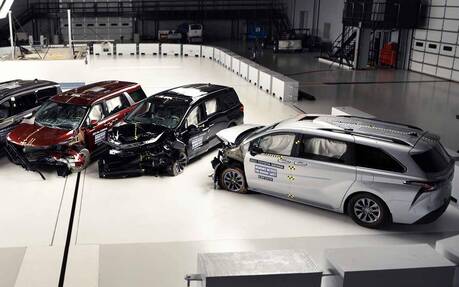Rear-Seat Passengers at Risk in Today's Minivans, IIHS Warns
You’d think modern minivans are some of the safest vehicles on the road especially when it comes to protecting all those kids sitting inside. As it turns out, they’re lagging behind.
None of the four MY2023 minivans recently tested by the U.S. Insurance Institute for Highway Safety (IIHS) earned an “acceptable” or “good” rating in the updated moderate overlap front crash test, which now emphasizes back seat safety. The Toyota Sienna, Chrysler Pacifica and Kia Carnival are rated “marginal,” while the Honda Odyssey is rated “poor.”
“Back seat safety is important for all vehicles, but it’s especially vital for those, like minivans, that customers are choosing specifically to transport their families,” said IIHS President David Harkey. “It’s disappointing that automakers haven’t acted faster to apply the best available technology to the second row in this vehicle class.”
The IIHS launched the updated moderate overlap front test last year after research showed that in newer vehicles the risk of a fatal injury is now higher for belted occupants in the second row than for those in front. This is not because the second row has become less safe. Rather, the front seat has become safer because of improved airbags and advanced seat belts that are rarely available in back.
Even with these developments, the IIHS claims the back seat remains the safest place for children, who can be injured by an inflating front airbag, and the rating does not apply to children secured properly in child safety seats.
All four minivans provide good protection in the front seat. However, each is plagued by multiple issues when it comes to the second row.
“The restraint systems in all four vehicles leave the second-row occupant vulnerable to chest injuries, either because of excessive belt forces or poor belt positioning,” said Jessica Jermakian, IIHS vice president of vehicle research. “That’s concerning because those injuries can be life-threatening.”
Of the four vehicles, only the marginal-rated Sienna is equipped with belt pretensioners and force limiters, technologies designed to reduce belt forces. Yet, the rear dummy submarined beneath the lap belt, and the shoulder belt migrated off the shoulder toward the dummy’s neck during the test.
In the two other marginal vehicles, the Carnival and Pacifica, the seat belt exerted too much force on the dummy’s chest. The side curtain airbag of the Pacifica also did not deploy during the test.
The forces on the rear dummy’s neck were within reasonable limits in the Pacifica and Sienna but substantially higher in the Carnival, increasing the chances of a head or neck injury.
In the poor-rated Odyssey, the forces on the head and neck were higher still, and the crash video demonstrated that the rear seat belt allowed the dummy’s head to come too close to the front seatback, which also increases the risk of head injuries.
